![[Snakeroot Organic Farm logo]](pix/sof.gif)
At dawn
Canoe bow waves are quickly lost
on the shoreside
But go on out of sight
on the lake side.
-1986
The constant swish-swish of skis
On a day long ski.
The constant swish-swish of wiper blades
On a day long drive.
-1990
My dog, trotting barefoot
Steps on a garden slug
And thinks
Nothing of it.
-1999
Word spreads quickly
as I approach the pond.
All becomes quiet.
-1997
Hidden in the vines
a large warted cucumber
jumps out of reach.
A toad!
-1997
Delicate puffs
of marshmallow snow
carefully perched
on a branch,
await the trigger of my hat
to melt their way down my back.
-2010
Deep in the tomato jungle
Fruits of yellow, purple and red
Tell of their readiness
To go to market.
-2010
Sugarin' Chores
Snowflakes hurry through my flashlight beam,
As my boots knead new snow with spring mud,
On my nightly Hajj to keep the boil alive,
For as long as possible until the dawn,
To match the power of the flowing sap,
With my meager evaporator and will.
The prize at the finish line are jars of syrup
And Spring.
-2013
USING MULCHESatSnakeroot Organic Farm |
|
Many folks confuse these three terms, so to begin with, let's look at some definitions: Almost anything can be used as a mulching material, depending upon what you wish to accomplish and what you have available to use. Stone mulches are used in hot climates to reduce soil moisture evaporation while allowing rain to infiltrate into the soil. Plastic mulches are often used to reduce moisture loss, suppress weed growth and warm the soil. Clear plastics warm the soil best, but allow weeds to grow under the plastic. IRT (infra red transmissive) mulches are second best at warming the soil, while not allowing light wavelengths through which encourage weed growth. Their reddish tint also reflects that color back to the plant, enhancing growth and detering some insects. There are reflective aluminized mulches and paper mulches, both quite expensive when it comes to covering more than 50 feet or so. The trouble with all plastic mulches, regardless of their various benefits, is that they need to be removed at some point—usually after the first season—and disposed of. In other words, those who are using plastic mulches are utilizing a petrochemical resource for a single season, and then adding it to the community's land fill. Very few of these dirty "ag plastics" are ever recycled.
Our mulching materials come to us via several methods over the course of a year. Newspapers are delivered daily to our door via subscription. Cereal boxes and pizza boxes arrive in the usual way and when empty are added to the pile of newspapers. In the fall and spring, residents bring carloads, van loads, trailer loads and pickup loads of leaves, pine needles, and hay, either bagged, baled or loose. Some days we get over a dozen deliveries, some days none. When the piles start to spread out, I use the bucket loader to push them together and pile them higher.
What organic mulches do. As any organic farmer will tell you, nothing on the farm should be seen to have only one purpose. Organic mulches are an excellent example of this. In winter, the mulches even out the swings in temperature, causing the soil to slowly freeze, and then slowly thaw in the spring. Plants and bulbs like this. During the growing season, organic mulches keep the soil cool and moist, so sometimes irrigation is unecessary even in a dry year. Organic mulches suppress weeds, especially the annual broadleaf weeds. Organic mulches add organic matter to the soil when turned under, but even before being turned under, they make the top inch of the soil more usable to the plant roots and earthworms than it would be otherwise, since it does not bake in the sun. When you don't apply a mulch, you are essentially mulching your soil using your top ½" - 1" of soil. Once we have the mulches at hand, how do we use them? Much of our leaf pile will be used not for mulch at all, but for composting with cow manure when the dairy farmer delivers it. They get mixed together and turned several times during the year, then spread on the fields the next year. The rest of the leaf pile to be used for mulch gets sorted into regular leaves, pine needles or needle & leaf mixes, and shredded leaves. We mulch our celery, tomatoes, peppers, asparagus, rhubarb, grapes, garlic, onion sets, and woody herbs. As each of these crops requires its own type of management, we use different kinds of mulches that will match the requirements of the plants. All of our other crops do not get mulched, altho they may benefit from the previous crop's mulch having been incorporated into the soil. Celery get mulched with hay several inches thick. We grow a double row of celery on a foot wide, foot high bed, and the mulch goes along the sides and between the rows. Celery likes to grow in moist soil, and the thick layer of hay helps retain moisure and suppress weeds. The mulch goes on once the celery has been in the ground three to four weeks and gets tucked right up next to each plant. We have learned, however, NOT to mulch celeriac very heavily, as the continuous soil surface moisture causes the top of the celeriac roots to become hairy with tiny rootlets. Tomatoes need to have the mulch applied after the June soil has warmed but before the plants tip over from the weight of their first fruits, or else the job will go much slower as you lift each plant carefully to tuck the mulch under it. Whole leaves work well for tomatoes, since they pack down into layers to suppress weeds, and are easy to tuck around the separate plants. Probably half our leaves are used to mulch our 3000 tomato plants. It's a lot of work, but it means the plants don't have to be trellised, and yet fruit won't be on the soil. Plus, we don't have to water the tomatoes as much. Peppers have an upright growth habit, so mulching can be delayed longer than for tomatoes. Since they prefer a well-warmed soil, the delay in mulching only warms their roots more. Mid to late July is when we get around to mulching our peppers. Leaves, hay or chips work well for mulching peppers. Asparagus is a perennial, and it has a vigorous sharp spear that emerges in the spring. Hence we mulch it with whole leaves, even covering the entire row several inches deep annually in late fall or early spring. Whole leaves are not only high in mineral content, but they mat down to form a barrier impenetrable to all but the most determined and energetic plants, such as asparagus. Also, the ends of the asparagus bed don't go all the way to the edge of the garden, in order that an area can be tilled to prevent the perennial rhizome grasses from moving in. Rhubarb is basically done the same as asparagus. Altho not equipped with pointed growing tips, rhubarb is vigorous enough to shove aside the leaves blocking it from emerging each spring. An annual or bi-annual application of leaves seems to be all the rhubarb wants in order to keep going for a decade or more. The water-loving rhubarb roots appreciate the constant moisture found under several inches of leaves.
|
 27 Organic Farm Road, Pittsfield Maine 04967 http://www.snakeroot.net/farm owned and operated by Tom Roberts & Lois Labbe Tom: Tom@snakeroot.net (cell) 207-416-5417 or Lois: Lois@snakeroot.net (cell) 207-416-5418 Gardening for the public since 1995. |
|
|

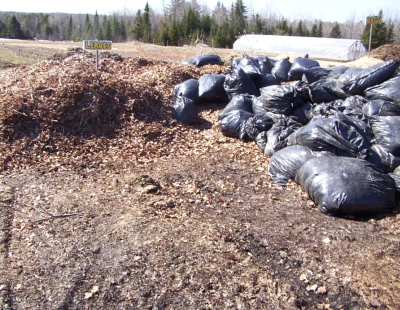 At Snakeroot, we use only
bio-degradable organic mulches of various types. Not only does that mean we are not faced
with the annual purchasing of these petrochemicals, and the fall labor chore of picking up and
"throwing away" the plastic, but all of our mulches are turned under to become an
integral part of our soil building program. Furthermore, we are utilizing mulching materials
that for the most part would otherwise become wastes for our town dump to handle. As an added
bonus, because of the relationship we have built with the town to become the residential
disposal location for these mulching products, all of our mulch products come to us at almost
no cost to ourselves in either labor or money. We have a
At Snakeroot, we use only
bio-degradable organic mulches of various types. Not only does that mean we are not faced
with the annual purchasing of these petrochemicals, and the fall labor chore of picking up and
"throwing away" the plastic, but all of our mulches are turned under to become an
integral part of our soil building program. Furthermore, we are utilizing mulching materials
that for the most part would otherwise become wastes for our town dump to handle. As an added
bonus, because of the relationship we have built with the town to become the residential
disposal location for these mulching products, all of our mulch products come to us at almost
no cost to ourselves in either labor or money. We have a 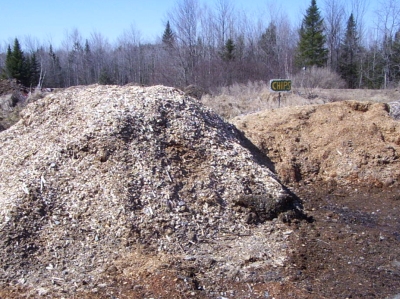 When the local electric
company has the chipper truck trim under the lines, the chipping crew has a disposal
problem once their truck is full. If we see them working nearby, we remind them where they can
dump all they have, whenever they have them. Similarly, the Town Highway Dept. sometimes needs
to chip fallen trees, and sends the dumptruck of chips up to us. Some homeowners do likewise.
For more on using chips, see our article
When the local electric
company has the chipper truck trim under the lines, the chipping crew has a disposal
problem once their truck is full. If we see them working nearby, we remind them where they can
dump all they have, whenever they have them. Similarly, the Town Highway Dept. sometimes needs
to chip fallen trees, and sends the dumptruck of chips up to us. Some homeowners do likewise.
For more on using chips, see our article 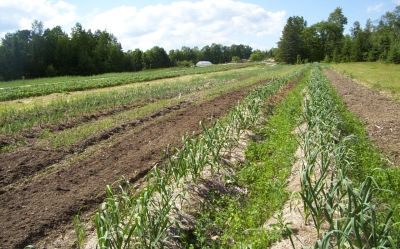
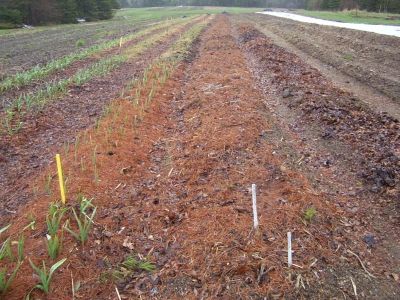
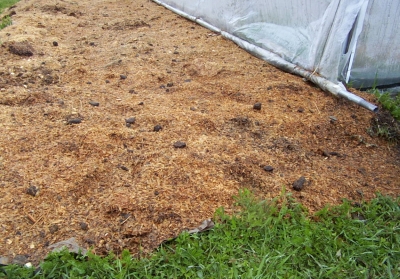 All high-celulose items such as sawdust, shavings and wood chips are very slow to degrade
once turned under and absorb nitrogen while rotting, robbing it from crop plants. Altho they work
well during the mulch year, extra nitrogen (compost, liquid fish) should be added the next
year to supply sufficient nitrogen for both the mulch to rot and the crops to grow. It is
better to use these items to mulch perennial areas where they will not be incorporated into
the soil, except by the microbes and earthworms over time.
All high-celulose items such as sawdust, shavings and wood chips are very slow to degrade
once turned under and absorb nitrogen while rotting, robbing it from crop plants. Altho they work
well during the mulch year, extra nitrogen (compost, liquid fish) should be added the next
year to supply sufficient nitrogen for both the mulch to rot and the crops to grow. It is
better to use these items to mulch perennial areas where they will not be incorporated into
the soil, except by the microbes and earthworms over time.
